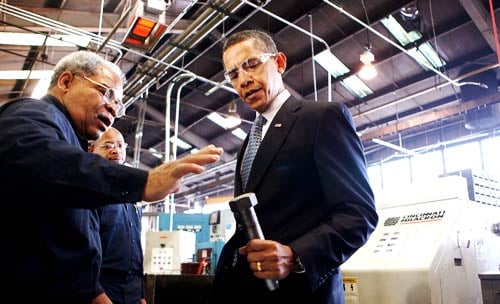
Editors' Note: Today marks the launch of "ShovelWatch," a joint effort by ProPublica, the public radio show "The Takeaway," and New Yorkâs public radio station, WNYC, to track the largest domestic spending bill in U.S. history. We will provide documents, data, and original reporting that will help readers monitor the programâs progress and efficacy. President Obama promises transparency. We promise to monitor adherence to that pledge and to put in perspective about the forthcoming flood of programs and data. Weâll be inviting you to join with us in spotting where the new efforts are working â and not working. The results will be crucial for all of us â as workers, taxpayers and voters. -- Paul Steiger & Stephen Engelberg
President Barack Obama has billed the $825 billion stimulus plan as an economic jolt that will âimmediately jump start job creationâ with âshovel-readyâ projects.
The rhetoric conjures the New Deal image of blue-collar workers heading out to Americaâs heartland with sledgehammers and pickaxes to build bridges, dams and grand public works projects.
But as currently drawn, much of the transportation and infrastructure spending wouldnât go to states with the highest unemployment rates, according to an analysis by ProPublica. In fact, most states with high unemployment would get less money per capita than states with low unemployment.
Wyoming has the lowest unemployment rate in the country at 3.2 percent â less than half the national average, according to the most recent figures from November. But under the bill (647-page pdf), it would get the third highest amount of infrastructure money per capita, about $451. Michigan â which at 9.6 percent has the highest unemployment â would get $124 per person.
The disparity highlights an emerging focus in the stimulus debate â whether money is targeted to true need. When it comes to roads and bridges, much of the difference is explained by existing funding formulas that take into account such factors as federal highway miles rather than economic measures such as unemployment or poverty.
Relying on those formulas was a deliberate choice made to avoid bogging down the bill in a political tug-of-war over which states deserve the most money. But the formulas also have a bias, favoring states with lots of roads and few people. They create their own pressure to balance the ledger.
When you add in proposed stimulus funding for school districts, food stamps, criminal justice grants and other programs, it helps bring spending closer to need as measured by economic indicators.
âIn a perfect world, there would be a way of making sure that money went where it was needed,â said Jim Berard, spokesman for the Democrats on the House Transportation and Infrastructure Committee. âBy using a system that has already been voted on, already in the law, we avoid that extended debate that would only serve to delay the passage of this bill.â
Although transportation and infrastructure projects make up less than 10 percent of the spending in the stimulus bill, they account for a large chunk of the jobs. President Obama has said the stimulus would create or save 3 million to 4 million jobs. A report by House Democrats estimates 1.7 million jobs would result from transportation and infrastructure projects.
ProPublica is studying the stimulus plan as part of a joint project called âShovelWatchâ with public radio station WNYC in New York City.
 Republicans have attacked some of the billâs priorities, saying much of the spending reflects the Democratsâ social welfare agenda and wonât really create jobs. Less than $100 billion worth of projects have job estimates attached to them in the 76-page House report on the bill from Rep. David Obey, D-Wis., chairman of the Appropriations Committee.
Republicans have attacked some of the billâs priorities, saying much of the spending reflects the Democratsâ social welfare agenda and wonât really create jobs. Less than $100 billion worth of projects have job estimates attached to them in the 76-page House report on the bill from Rep. David Obey, D-Wis., chairman of the Appropriations Committee.
And added up, the summaries of the bill posted on Speaker Nancy Pelosiâs Web site total $866 billion â $41 billion more than President Obama and House Democratic leaders have said they plan to spend. Calls to Obey and Pelosiâs offices and the White House were not returned.
At this early stage, the question of whether stimulus jobs will be created where theyâre needed most has no definitive answer. ProPublica looked not only at state-by-state funding for transportation, but for infrastructure, school districts, food stamps, shelters and criminal justice grants, measuring them against economic factors such as unemployment, poverty and gross domestic product.
Relationships with spending varied depending on which factors were included in the analysis.
Republicans have urged the Congress to slow down, given the complexity of predicting the billâs economic effects.
âIf this question is this difficult to answer, maybe we need to take time and think it through and have some hearings,â said Jennifer Hing, spokeswoman for the Republicans on the House Appropriations Committee.
The stimulus plan, formally called the American Recovery and Reinvestment Act, was unveiled Jan. 15 and is being fast-tracked for approval before Congress takes its Presidentâs Day recess. A House vote could come as early as Wednesday; Senate Democrats are working on their own stimulus version.
The measure also includes $280 billion in tax cuts, an extension of unemployment benefits, money to shore up state and local budgets and investments in alternative energy and scientific research.
There are many ways to analyze the House bill.
For example, while Wyoming would get a per capita spending windfall, it ranks further down in the list of states in spending per mile of highway, at $13,000. New Jersey would receive the most money per highway mile, at $91,000.
Factoring poverty in with unemployment yields a different view. Generally, states with both high poverty and unemployment would get more money per capita. Thatâs because school district and food stamp dollars are targeted to low-income areas.
Another way to examine the outlays is by state gross domestic product. Winners turn out to be states such as Montana, West Virginia and North Dakota with low GDPs in relation to stimulus money.
Even government analyses contradict each other.
A report by the nonpartisan Congressional Budget Office, touted by Republicans last week, showed that only 7 percent of outlays in the House bill would be spent by the end of fiscal 2009 and that less than half by the end of 2010. Republicans said thatâs too long to wait for jobs.
White House press secretary Robert Gibbs dismissed the CBO report, saying it covered only part of the bill and didnât consider provisions to speed up spending. An analysis by the White House Office of Management and Budget, which considered tax cuts and expanded unemployment, indicated that at least 75 percent would be spent within 18 months.
Some in Congress put the equity issue front and center.
âMichiganâs strong manufacturing base is critical to our stateâs economy and that of our nation, and that manufacturing base has been hit hard by the current economic downturn,â Rep. Candice Miller, a Republican from eastern Michigan, said in a statement Friday. âOur delegation is united in the belief that the economic recovery plan must target states with higher unemployment rates.â
House Democrats have made efforts to do that. Last week, the Appropriations Committee agreed that at least 10 percent of Agriculture Department rural development funds to counties with persistent poverty. The bill also directs states to prioritize transportation projects that benefit economically distressed areas.
How this will play out at the ground level poses some interesting questions.
Would Wyoming hire workers from out of state? Would Michigan have to cut a project from its priority list in favor of one for Wyoming? If Wyomingâs unemployment rate drops to nearly zero while Michiganâs stays the same, would the economic stimulus be a success?
Wyoming might not have high unemployment now, but its economy could end up lagging longer than the rest of the country, said Cara Eastwood, spokeswoman for Gov. Dave Freudenthal.
âWeâre a natural resource based economy,â she said. âSo when you see durable goods manufacturing going down across the country, well, we produce the natural gas that heats those factories and some of the raw materials that goes into plastics. So thereâs sort of a slower ripple effect that eventually hits here.â
Wenlin Liu, senior economist with Wyomingâs economic analysis division, said Wyoming provides financial benefits for the rest of the country. If Interstate 80 needs repairs in Wyoming, it affects the transportation of goods from San Francisco to New York.
âAll this truck traffic isnât necessarily serving Wyomingâs residents; itâs mostly serving other states,â Liu said.
The American Association of State Highway and Transportation Officials says that the 1.4 million unemployed construction workers will follow the jobs as people did during the Depression.
That was the case during the downturn in the early 1990s, Mr. Liu said, when workers fled high unemployment in California for jobs in Rocky Mountain states.
Ron Blackwell, chief economist for the AFL-CIO, agreed that jobs should be targeted for needy areas, but said the issue should be examined globally.
âItâs not just about us; itâs about getting the world economy going,â Blackwell said. âTimes is wasting. It is essential to start creating those jobs. A day or a week when we donât get something moving, we risk not being able to turn this around.â



